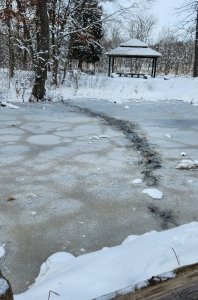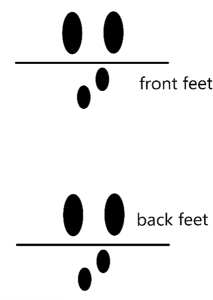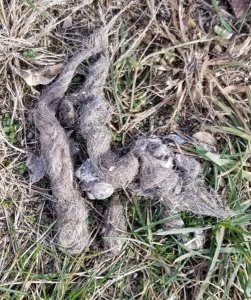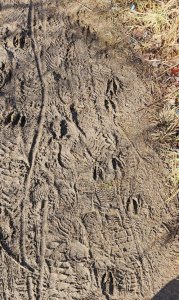Connecting with the past through scat, tracks, and signs.
January 10, 2024
by Ali Groulx, park interpreter

There is a bit of a walk from the parking lot to the Kensington Nature Center. Normally, this is something I cherish, looking out for wildlife as I head down the paved path that intersects Kingfisher’s Lagoon and a small pond. Last January, though, the freezing temperatures put an unusual pep in my step; my goal was to get to the front door without catching a chill. Of course, as it were, Mother Nature did not want me to breeze through her scenery. As I glanced toward the shallow waters, they looked to be frozen solid. The cranes lamented their iced-over buffet, but the deer cherished it; the quickest way from point A to B is a straight line, after all. I stopped short. There was something odd about the ice on the small pond to my left… and when I realized what I was seeing, I immediately pulled my hands out of my warm pockets to snap a photo. The evidence was worth it. As I studied the ice, I figured that a young, naïve deer decided to chance their fate for a shortcut. As the water is not very deep, the risk was not a matter of life or death. I was shocked and amused that the poor dude was committed to their trudge through the ice, even after breaking through. Around the world, humans hold a long tradition of seeking to understand the beings around them by using clues left behind. Winter is the perfect time to slow down and listen to the tales that Mother Nature is sharing with us.
Every being creates an impression on their environment. The old farm fences hidden on Kensington’s Aspen Trail tell of the former tenants of the lost town of Kent. Holes in the nearby trees indicate the current inhabitants of this space; raccoons and opossums love to claim an old woodpecker cavity. Gnawed branches and hoof marks tell of passing deer searching for food. Tracks can tell us more than just who left them. Thought processes can be discovered by following a trail of tracks; from the curious dog’s trail between urine-marked mailboxes, the deer’s well-trodden path through deep snow, or a bird’s landing indicated by feathery impressions. As a light dusting of snow covers the Earth overnight, stories are etched by nature’s mysteries upon a disappearing slate. These signs of life connect moments in time.

When food is scarce and temperatures drop, animals need to pick and choose their movements based on how much energy is available. For safety and energy conservation, cotton-tail rabbits keep to a small range during the winter. In this season, their diet consists of woody twigs and buds from saplings or shrubs. Their sharp front teeth neatly cut at a 45° angle, and often they leave scat nearby their feeding areas. Scat is the term used to describe the poop left behind. Rabbit scat is unique. They excrete two types of waste – first, they produce caecal pellets, or cecotropes, which contain minerals, vitamins, proteins, and other beneficial bacteria. You will not be able to find this scat, because rabbits eat it immediately! After the second digestion, their scat is left behind in the form of small, slightly flattened spheres. They prefer to leave their scat in the same place throughout the season, creating piles. Rabbit signs were one of the first that I became familiar with; the rounded balls of scat are amusing to find, and their tracks are easily identified. Many childhood afternoons were spent attempting to recreate their oval-shaped galloping bounds by placing my fingertips and knuckles in the snow. Their front feet are immediately followed by their larger back feet, creating obvious signs of their presence. Galloping is the common mode of travel for squirrel and mouse species, too, especially across dangerous open spaces. As the animal bounds along, their back feet land in line or slightly ahead of their front feet, creating the force that propels them forward.

Domestic dogs and cats create tracks in a straight line just like their wild counterparts. In southeast Michigan, these include canines like the coyote and fox, and felines like the bobcat. Recognizing the difference between domestic and wild tracks requires the entire path to be considered. Species in the canine family leave behind claw marks above their toe pads. Canines use their claws for traction and digging, relying on their teeth and speed for hunting. On the other paw, grey foxes and felines use their claws for hunting and they need to remain sharp for tree-climbing. Their claws retract into their paws to keep them safe. This leaves tracks that only include the pads of their paws. Scat from canines varies wildly depending on diet. It can contain fur, bone, or berries, but scat that contains fur is typically from a wild canine like a coyote. After excreting waste and urinating, most canines scrape the ground with their back feet. Along their paths, both canines and felines mark territory and communicate using their urine. For wild felines, their scats are tube shaped and smooth with fur and bone twisted inside. Sometimes they will bury their scat, much like our domestic cats do in their litter boxes. Our domestic animals have it easy; they can wander and be curious about their surroundings. Their scat hardly contains fur or bone since they are fed special food by their human companions.

Non-human footprints create a sense of wonder and curiosity about our environments. Who is really living around us? Many animals make tracks along the same paths that we use. After all, most nature trails follow paths that have existed for centuries, flattened down by animals and humans alike. Following a path created by an animal speaks to a tradition that dates to the origin of our species. Although most of us exist in towns and cities, we can connect with nature and our ancestors by looking out for signs left behind by other beings. It may require slowing down, and it may involve trekking through the snow, but the insight we can gain by doing so is invaluable. The next time you walk around your neighborhood or down your favorite Metropark nature trail, look for the signs of the mysterious, mystical galivants that our animal counterparts leave behind for us to interpret. You never know what curiosities you and your loved ones may discover!
SOURCES AND FURTHER READING:
Nature In Winter by Donald Stokes
Mammal Tracks and Sign by Mark Elbroch
